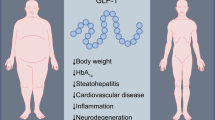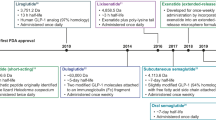Abstract
Purpose
To study the ability of a novel bovine serum albumin-angiotensin II (BSA-Ang II) conjugate to effect responses of the AT1 angiotensin II receptor subtype mediated by the G-protein-coupled and the beta-arrestin pathways.
Methods
Angiotensin II (Ang II) was conjugated with bovine serum albumin and compared with Ang II for competition binding to AT1 receptors, to stimulate aldosterone release from adrenocortical cells, to promote beta-arrestin binding to AT1 receptors, to promote calcium mobilization, and stimulate drinking of water and saline by rats.
Results
The BSA-Ang II conjugate was less potent competing for AT1R binding, but was equally efficacious at stimulating aldosterone release from H295R adrenocortical cells. Both BSA-Ang II and Ang II stimulated calcium mobilization and beta-arrestin binding to AT1 receptors. BSA-Ang II and Ang II stimulated water appetite equivalently but BSA-Ang II stimulated saline appetite more than Ang II. Both BSA-Ang II and Ang II were considerably more potent at causing calcium mobilization than β-arrestin binding.
Conclusions
Addition of a high molecular weight molecule to Ang II reduced its AT1 receptor binding affinity, but did not significantly alter stimulation of aldosterone release or water consumption. The BSA-Ang II conjugate caused a greater saline appetite than Ang II suggesting that it may be a more efficacious agonist of this beta-arrestin-mediated response than Ang II. The higher potency calcium signaling response suggests that the G-protein-coupled responses predominate at physiological concentrations of Ang II, while the beta-arrestin response requires pathophysiological or pharmacological concentrations of Ang II to occur.







Similar content being viewed by others
Abbreviations
- Ang II:
-
angiotensin II;
- ARBs:
-
angiotensin receptor blockers;
- AT1R:
-
angiotensin II receptor subtype 1;
- AT2R:
-
angiotensin II receptor subtype 2;
- BSA-Ang II:
-
Ang II conjugated to bovine albumin;
- G-protein:
-
guanine nucleotide binding protein;
- GPCR:
-
G-protein-coupled receptors;
- ICV:
-
intracerebroventricular;
- MAPK:
-
mitogen-activated protein kinase;
- SI Ang II:
-
Sarcosine1 Isoleucine8 angiotensin II;
- SII Ang II:
-
Sarcosine1 Isoleucine4 Isoleucine8 angiotensin II;
- SMCC:
-
succinimydyl 4-[N-maleimidomethyl1]cyclohexane-1-carboxylate.
References
S.D. Crowley, S.B. Gurley, M.I. Oliverio, A.K. Pazmino, R. Griffiths, P.J. Flannery, R.F. Spurney, H.S. Kim, O. Smithies, T.H. Le, T.M. Coffman, Distinct roles for the kidney and systemic tissues in blood pressure regulation by the renin-angiotensin system. J. Clin. Invest. 115(4), 1092–1099 (2005)
S.S. Karnik, H. Unal, J.R. Kemp, K.C. Tirupula, S. Eguchi, P.M. Vanderheyden, W.G. Thomas, International Union of Basic and Clinical Pharmacology. XCIX. Angiotensin receptors: interpreters of pathophysiological angiotensinergic stimuli. Pharmacol. Rev. 67(4), 754–819 (2015). https://doi.org/10.1124/pr.114.010454
F. Jaisser, N. Farman, Emerging roles of the mineralocorticoid receptor in pathology: toward new paradigms in clinical pharmacology. Pharmacol. Rev. 68(1), 49–75 (2016). https://doi.org/10.1124/pr.115.011106
M. Postolache, J. Santollo, D. Daniels, Associative learning contributes to the increased water intake observed after daily injections of angiotensin II. Physiol. Behav. 179, 340–345 (2017). https://doi.org/10.1016/j.physbeh.2017.07.005
Y. Oka, M. Ye, C.S. Zuker, Thirst driving and suppressing signals encoded by distinct neural populations in the brain. Nature 520(7547), 349–352 (2015). https://doi.org/10.1038/nature14108
D.A. Booth, Mechanism of action of norepinephrine in eliciting an eating response on injection into the rat hypothalamus. J. Pharmacol. Exp. Ther. 160(2), 336–348 (1968)
J.T. Fitzsimons, E.M. Stricker, Sodium appetite and the renin-angiotensin system. Nat.: New Biol. 231(19), 58–60 (1971)
J.T. Fitzsimons, Angiotensin, thirst, and sodium appetite: retrospect and prospect. Fed. Proc. 37(13), 2669–2675 (1978)
P.J. Harris, Stimulation of proximal tubular sodium reabsorption by Ile5 angiotensin II in the rat kidney. Pflug. Arch. 369, 83–85 (1979)
P.B. Timmermans, P. Benfield, A.T. Chiu, W.F. Herblin, P.C. Wong, R.D. Smith, Angiotensin II receptors and functional correlates. Am. J. Hypertens. 5(12 Pt 2), 221S–235S (1992)
S. AbdAlla, H. Lother, U. Quitterer, AT1-receptor heterodimers show enhanced G-protein activation and altered receptor sequestration. Nature 407(6800), 94–98 (2000)
Y. Daaka, L.M. Luttrell, S. Ahn, G.J. Della Rocca, S.S. Ferguson, M.G. Caron, R.J. Lefkowitz, Essential role for G protein-coupled receptor endocytosis in the activation of mitogen-activated protein kinase. J. Biol. Chem. 273(2), 685–688 (1998)
L.M. Luttrell, F.L. Roudabush, E.W. Choy, W.E. Miller, M.E. Field, K.L. Pierce, R.J. Lefkowitz, Activation and targeting of extracellular signal-regulated kinases by beta-arrestin scaffolds. Proc. Natl Acad. Sci. USA 98(5), 2449–2454 (2001). https://doi.org/10.1073/pnas.041604898
Kohout, T. A., Lin, F. S., Perry, S. J., Conner, D. A., Lefkowitz, R. J.: beta-Arrestin 1 and 2 differentially regulate heptahelical receptor signaling and trafficking. Proc. Natl Acad. Sci. USA 98(4), 1601–1606 (2001). https://doi.org/10.1073/pnas.041608198
R.H. Oakley, S.A. Laporte, J.A. Holt, M.G. Caron, L.S. Barak, Differential affinities of visual arrestin, betaarrestin1, and beta arrestin2 for G protein-coupled receptors delineate two major classes of receptors. J. Biol. Chem. 275(22), 17201–17210 (2000). https://doi.org/10.1074/jbc.M910348199
R.J. Lefkowitz, K. Rajagopal, E.J. Whalen, New roles for beta-arrestins in cell signaling: not just for seven-transmembrane receptors. Mol. cell 24(5), 643–652 (2006). https://doi.org/10.1016/j.molcel.2006.11.007
M.M. Monasky, D.M. Taglieri, M. Henze, C.M. Warren, M.S. Utter, D.G. Soergel, J.D. Violin, R.J. Solaro, The beta-arrestin-biased ligand TRV120023 inhibits angiotensin II-induced cardiac hypertrophy while preserving enhanced myofilament response to calcium. Am. J. Physiol. Heart Circ. Physiol. 305(6), H856–866 (2013). https://doi.org/10.1152/ajpheart.00327.2013
D.G. Romero, M.Y. Zhou, L.L. Yanes, M.W. Plonczynski, T.R. Washington, C.E. Gomez-Sanchez, E.P. Gomez-Sanchez, Regulators of G-protein signaling 4 in adrenal gland: localization, regulation, and role in aldosterone secretion. J. Endocrinol. 194(2), 429–440 (2007). https://doi.org/10.1677/joe-07-0153
A. Lymperopoulos, G. Rengo, C. Zincarelli, J. Kim, S. Soltys, W.J. Koch, An adrenal beta-arrestin 1-mediated signaling pathway underlies angiotensin II-induced aldosterone production in vitro and in vivo. Proc. Natl Acad. Sci. USA 106(14), 5825–5830 (2009). https://doi.org/10.1073/pnas.0811706106
H. Rasmussen, C.M. Isales, R. Calle, D. Throckmorton, M. Anderson, J. Gasalla-Herraiz, R. McCarthy, Diacylglycerol production, Ca2+ influx, and protein kinase C activation in sustained cellular responses. Endocr. Rev. 16(5), 649–681 (1995). https://doi.org/10.1210/edrv-16-5-649
A.C. Holloway, H. Qian, L. Pipolo, J. Ziogas, S. Miura, S. Karnik, B.R. Southwell, M.J. Lew, W.G. Thomas, Side-chain substitutions within angiotensin II reveal different requirements for signaling, internalization, and phosphorylation of type 1A angiotensin receptors. Mol. Pharmacol. 61(4), 768–777 (2002)
J.D. Violin, S.M. DeWire, D. Yamashita, D.H. Rominger, L. Nguyen, K. Schiller, E.J. Whalen, M. Gowen, M.W. Lark, Selectively engaging beta-arrestins at the angiotensin II type 1 receptor reduces blood pressure and increases cardiac performance. J. Pharmacol. Exp. Ther. 335(3), 572–579 (2010). https://doi.org/10.1124/jpet.110.173005
B. Greenberg, Novel therapies for heart failure- where do they stand? Circ. J. 80(9), 1882–1891 (2016). https://doi.org/10.1253/circj.CJ-16-0742
D. Daniels, D.K. Yee, L.F. Faulconbridge, S.J. Fluharty, Divergent behavioral roles of angiotensin receptor intracellular signaling cascades. Endocrinology 146(12), 5552–5560 (2005)
D. Daniels, E.G. Mietlicki, E.L. Nowak, S.J. Fluharty, Angiotensin II stimulates water and NaCl intake through separate cell signalling pathways in rats. Exp. Physiol. 94(1), 130–137 (2009)
J. Liu, G.L. Yosten, H. Ji, D. Zhang, W. Zheng, R. C. Speth, W. K. Samson, K. Sandberg, Selective inhibition of angiotensin receptor signaling through Erk1/2 pathway by a novel peptide. Am. J. Physiol. Regul. Integr. Comp. Physiol. (2014). https://doi.org/10.1152/ajpregu.00562.2013
D. Torres-Tirado, J. Ramiro-Diaz, M.T. Knabb, R. Rubio, Molecular weight of different angiotensin II polymers directly determines: density of endothelial membrane AT1 receptors and coronary vasoconstriction. Vasc. Pharmacol. 58(5-6), 346–355 (2013). https://doi.org/10.1016/j.vph.2013.03.002
P.J. Vento, D. Daniels, Repeated administration of angiotensin II reduces its dipsogenic effect without affecting saline intake. Exp. Physiol. 95(6), 736–745 (2010)
J. Santollo, A.M. Torregrossa, D. Daniels, Sex differences in the drinking response to angiotensin II (AngII): Effect of body weight. Horm. Behav. 93, 128–136 (2017). https://doi.org/10.1016/j.yhbeh.2017.05.013
K.L. Grove, R.C. Speth, Angiotensin II and non-angiotensin II displaceable binding sites for [3H]losartan in the rat liver. Biochem. Pharmacol. 46(9), 1653–1660 (1993)
I.M. Bird, R.A. Word, C. Clyne, J.I. Mason, W.E. Rainey, Potassium negatively regulates angiotensin II type 1 receptor expression in human adrenocortical H295R cells. Hypertension 25(6), 1129–1134 (1995)
I.M. Bird, J.I. Mason, W.E. Rainey, Regulation of type 1 angiotensin II receptor messenger ribonucleic acid expression in human adrenocortical carcinoma H295 cells. Endocrinology 134, 2468–2474 (1994)
X. Lu, K.L. Grove, W. Zhang, R.C. Speth, Pharmacological characterization of angiotensin II AT(2) receptor subtype heterogeneity in the rat adrenal cortex and medulla. Endocrine 3(4), 255–261 (1995). https://doi.org/10.1007/bf03021402
J. Castillo-Hernandez, D. Torres-Tirado, A. Barajas-Espinosa, E. Chi-Ahumada, J. Ramiro-Diaz, G. Ceballos, R. Rubio, Two dissimilar AT(1) agonists distinctively activate AT(1) receptors located on the luminal membrane of coronary endothelium. Vasc. Pharmacol. 51(5-6), 314–322 (2009). https://doi.org/10.1016/j.vph.2009.07.003
I.M. Bird, N.A. Hanley, R.A. Word, J.M. Mathis, J.L. McCarthy, J.I. Mason, W.E. Rainey, Human NCI-H295 adrenocortical carcinoma cells: a model for angiotensin-II-responsive aldosterone secretion. Endocrinology 133(4), 1555–1561 (1993). https://doi.org/10.1210/endo.133.4.8404594
M. Oppermann, N.J. Freedman, R.W. Alexander, R.J. Lefkowitz, Phosphorylation of the type 1A angiotensin II receptor by G protein-coupled receptor kinases and protein kinase C. J. Biol. Chem. 271, 13266–13272 (1996)
T. Inagami, S. Eguchi, K. Numaguchi, E.D. Motley, H. Tang, T. Matsumoto, T. Yamakawa, Cross-talk between angiotensin II receptors and the tyrosine kinases and phosphatases. J. Am. Soc. Nephrol.: JASN 10(Suppl 11), S57–61 (1999)
C.M. Godin, S.S. Ferguson, Biased agonism of the angiotensin II type 1 receptor. Mini Rev. Med. Chem. 12(9), 812–816 (2012)
K. Eichel, D. Jullié, B. Barsi-Rhyne, N.R. Latorraca, M. Masureel, J.-B. Sibarita, R.O. Dror, M. von Zastrow, Catalytic activation of β-arrestin by GPCRs. Nature 557(7705), 381–386 (2018). https://doi.org/10.1038/s41586-018-0079-1
K. Eichel, D. Jullie, M. von Zastrow, beta-Arrestin drives MAP kinase signalling from clathrin-coated structures after GPCR dissociation. Nat. Cell Biol. 18(3), 303–310 (2016). https://doi.org/10.1038/ncb3307
G. Mariani, S. Ito, R.C. Nayak, J. Baranowska-Kortylewicz, C.N. Venkateshan, A.D. Van den Abbeele, G.S. Eisenbarth, S.J. Adelstein, A.I: Kassis, Capping and internalization of a monoclonal antibody-surface antigen complex: a possible mode of interaction of monoclonal antibodies and tumor cells. J. Nucl. Biol. Med. (Turin, Italy.: 1991) 35(2), 111–119 (1991)
O. Behnke, Surface membrane clearing of receptor-ligand complexes in human blood platelets. J. cell Sci. 87(Pt 3), 465–472 (1987)
Acknowledgements
The authors thank Dr. Anastasios Lymperopoulos for assistance in experimental design and Dr. Douglas Lappi and Denise Higgins for editorial suggestions. This study was funded by a President’s Faculty Research Development Grant from Nova Southeastern University and the Cardiovascular Neuroscience Fund, Nova Southeastern University and NIH, HL-113905.
Author contributions
Participated in research design: H.W.P., A.L., L.C., J.S., D.D., and R.C.S.; Conducted experiments and performed data analysis: H.W.P., A.L., L.C., J.S., L.A., D.D., and R.C.S.; Wrote or contributed to the writing of the manuscript: H.W.P., J.S., L.A., D.D., and R.C.S.
Author information
Authors and Affiliations
Corresponding author
Ethics declarations
Conflict of interest
The authors declare that they have no conflict of interest.
Additional information
Publisher’s note: Springer Nature remains neutral with regard to jurisdictional claims in published maps and institutional affiliations.
Rights and permissions
About this article
Cite this article
Pang, H.W., Linares, A., Couling, L. et al. Novel high molecular weight albumin-conjugated angiotensin II activates β-arrestin and G-protein pathways. Endocrine 66, 349–359 (2019). https://doi.org/10.1007/s12020-019-01930-z
Received:
Accepted:
Published:
Issue Date:
DOI: https://doi.org/10.1007/s12020-019-01930-z




